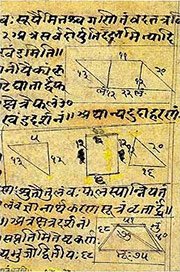Bhajya: 14 definitions
Introduction:
Bhajya means something in Hinduism, Sanskrit, Marathi, Hindi. If you want to know the exact meaning, history, etymology or English translation of this term then check out the descriptions on this page. Add your comment or reference to a book if you want to contribute to this summary article.
Alternative spellings of this word include Bhajy.
In Hinduism
Purana and Itihasa (epic history)
Source: archive.org: Puranic EncyclopediaBhajya (भज्य).—An ācārya in the line of the Ṛk disciples of Vyāsa. Bhajya studied Vālakhilyasaṃhitā at the feet of his guru Bāṣkali. (Bhāgavata, Dvādaśa Skandha).
Source: Cologne Digital Sanskrit Dictionaries: The Purana IndexBhajya (भज्य).—A pupil of Bāṣkali.*
- * Bhāgavata-purāṇa XII. 6. 59.

The Purana (पुराण, purāṇas) refers to Sanskrit literature preserving ancient India’s vast cultural history, including historical legends, religious ceremonies, various arts and sciences. The eighteen mahapuranas total over 400,000 shlokas (metrical couplets) and date to at least several centuries BCE.
Ganitashastra (Mathematics and Algebra)
Source: archive.org: Hindu MathematicsBhājya (भाज्य) refers to the “dividend” in bhāgahāra (“division”), which refers to one of the twenty operations (logistics) of pāṭīgaṇita (“science of calculation which requires the use of writing material—the board”), according to Pṛthudakasvāmī’s commentary on the Brāhmasphuṭasiddhānta by Brahmagupta, a Sanskrit treatise on ancient Indian mathematics (gaṇita-śāstra) and astronomy from the 7th century.—The common Hindu names for the operation are bhāgahāra, bhājana, haraṇa, chedana, etc. All these terms literally mean “to break into parts”, i.e., “to divide”, excepting haraṇa which denotes “to take away”. This term shows the relation of division to subtraction. The dividend is termed bhājya, hārya, etc., the divisor bhājaka, bhāgahara or simply hara, and the quotient labdhi “what is obtained” or labdha.

Ganitashastra (शिल्पशास्त्र, gaṇitaśāstra) refers to the ancient Indian science of mathematics, algebra, number theory, arithmetic, etc. Closely allied with astronomy, both were commonly taught and studied in universities, even since the 1st millennium BCE. Ganita-shastra also includes ritualistic math-books such as the Shulba-sutras.
Languages of India and abroad
Marathi-English dictionary
Source: DDSA: The Molesworth Marathi and English Dictionarybhājya (भाज्य).—n (S) In arithmetic. Dividend.
--- OR ---
bhājya (भाज्य).—a S (Possible, purposed, necessary, fit) to be divided or portioned; divisible, distributable.
Source: DDSA: The Aryabhusan school dictionary, Marathi-Englishbhajya (भज्य).—a Worthy of worship or service.
--- OR ---
bhājya (भाज्य).—
--- OR ---
bhājya (भाज्य).—a Divisible.
Marathi is an Indo-European language having over 70 million native speakers people in (predominantly) Maharashtra India. Marathi, like many other Indo-Aryan languages, evolved from early forms of Prakrit, which itself is a subset of Sanskrit, one of the most ancient languages of the world.
Sanskrit dictionary
Source: DDSA: The practical Sanskrit-English dictionaryBhājya (भाज्य).—a. [bhaj-ṇyat] Divisible.
-jyam 1 A portion, share.
2) An inheritance.
3) (In arith.) The dividend.
Source: Cologne Digital Sanskrit Dictionaries: Shabda-Sagara Sanskrit-English DictionaryBhājya (भाज्य).—mfn.
(-jyaḥ-jyā-jyaṃ) Divisible, to be portioned or divided. n.
(-jyaṃ) 1. A portion, a share, an inheritance. 2. (In arithmetic.) The dividend. E. bhāj to divide, aff. yat; or bhaj-ṇyat aff.
Source: Cologne Digital Sanskrit Dictionaries: Cappeller Sanskrit-English DictionaryBhājya (भाज्य).—[adjective] to be distributed or divided.
Source: Cologne Digital Sanskrit Dictionaries: Monier-Williams Sanskrit-English Dictionary1) Bhajya (भज्य):—[from bhajaka > bhaj] ([Vopadeva]) mfn. = janīya.
2) Bhājya (भाज्य):—[from bhāga] mfn. to be shared or distributed etc.
3) [v.s. ...] (in [arithmetic]) to be divided, as [substantive] = a dividend, [Siddhāntaśiromaṇi]
Source: Cologne Digital Sanskrit Dictionaries: Yates Sanskrit-English DictionaryBhājya (भाज्य):—(jyaṃ) 1. n. A portion, a share; the dividend. a. Divisible.
[Sanskrit to German]
Sanskrit, also spelled संस्कृतम् (saṃskṛtam), is an ancient language of India commonly seen as the grandmother of the Indo-European language family (even English!). Closely allied with Prakrit and Pali, Sanskrit is more exhaustive in both grammar and terms and has the most extensive collection of literature in the world, greatly surpassing its sister-languages Greek and Latin.
Hindi dictionary
Source: DDSA: A practical Hindi-English dictionaryBhājya (भाज्य) [Also spelled bhajy]:—(nm) a dividend; (a) divisible; ~[phala] the quotient.
...
Kannada-English dictionary
Source: Alar: Kannada-English corpusBhājya (ಭಾಜ್ಯ):—[adjective] that is to be or can be divided.
--- OR ---
Bhājya (ಭಾಜ್ಯ):—
1) [noun] that which is to be divided.
2) [noun] a share or portion of a hereditary property.
3) [noun] (math.) the number or quantity to be divided; a dividend.
Kannada is a Dravidian language (as opposed to the Indo-European language family) mainly spoken in the southwestern region of India.
See also (Relevant definitions)
Starts with: Bhajyani.
Ends with: Abhajya, Avibhajya, Durvibhajya, Nirbhajya, Sabhajya, Samvibhajya, Tribhajya, Vibhajya.
Full-text (+4): Vibhajya, Nirbhajya, Vibhajyavada, Paribhaj, Vibhajyavadin, Vibhajyapatha, Bhajaniya, Prativibhaj, Bhajy, Triputi, Sodhya, Bhagya, Harya, Chedana, Harana, Bhajana, Bhajaka, Bhanj, Bhaj, Ghanamula.
Relevant text
Search found 3 books and stories containing Bhajya, Bhājya; (plurals include: Bhajyas, Bhājyas). You can also click to the full overview containing English textual excerpts. Below are direct links for the most relevant articles:
Tattvartha Sutra (with commentary) (by Vijay K. Jain)
Verse 5.14 - Occupation of the forms of matter (pudgala) < [Chapter 5 - The Non-living Substances]
Kashyapa Shilpa-shastra (study) (by K. Vidyuta)
4. Prākāra components (2): Pāda-māna < [Chapter 3 - Prākāra Lakṣaṇa]
3. The Breadth, Length and Height of the Gopuras < [Chapter 5 - Gopura Lakṣaṇa]
The Bhagavata Purana (by G. V. Tagare)
Chapter 6(b) - Classification of Vedas in Different Branches < [Book 12 - Twelfth Skandha]